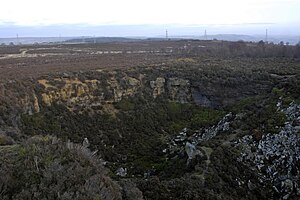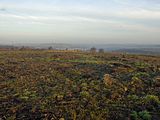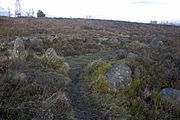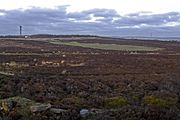Harden Moor
| Harden Moor | |||
| Yorkshire | |||
|---|---|---|---|
 Harden Moor looking towards Airedale | |||
| Range: | Yorkshire Dales | ||
| Summit: | 935 feet SE075390 | ||
Harden Moor is an expanse of moorland that lies north of the village of Harden in the West Riding of Yorkshire. The moor encompasses stretches of heather, woodland and former quarry workings and is bordered by Airedale to the east, the Worth Valley to the north and Catstones Moor and the village of Cullingworth to the west.
Historically, Harden Moor occupied the high ground between Bingley, Keighley, Cullingworth and Harden. Altar Lane, an unmade road which runs from the Brown Cow Inn in Bingley to Keighley Road on Harden Moor. When the St Ives Estate was created, a large swathe of Harden Moor was taken over.
The moorland has a varied history, with a Roman Road, industrial workings and modern-day leisure activities.
History
Before the St Ives estate was formed, Harden Moor stretched from Bingley in the east to Cullingworth in the west. In 13th century deeds, Ellar Carr Beck (which drains down from Lees Moor and skirts the northern edge of Cullingworth) was defined as the western edge of Harden.[1] This area included Catstones Moor and north up to Hainworth Shaw. Opinions vary as to what the boundaries of Harden Moor are; 18th and 19th century texts describe Harden Moor as including Altar Rock (Druid's Altar) and the land surrounding.[2] In modern archaeological data, Adrian Chadwick describes Catstones Ring on Catstones Moor as being on the southwestern edge of Harden Moor.[3]
The history of Harden Moor goes back to the Bronze Age and this is evidenced by the cairns on the moor, which can date from anywhere between 2000 BC and 700 BC: these are examples of Bronze Age burial mounds.[4][5]
Cup and ringlet marks have been found carved in Altar Rock (also popularly known as Druid's Altar). A Roman Road crosses Harden Moor on a south-west to north-east axis, which road started in Mamucium (Manchester) and continued north to Ilkley going through Riddlesden, Morton Banks and Rombalds Moor to what was the Roman encampment known as Olicana.[6][7] A second Roman road passed through Harden village and crossed Harden Beck by the Malt Shovel inn. It then went in a north westerly direction passing near to the hamlet of Ryecroft and crossing the moor near to Ryecroft Road. Remains of this road can still be seen on the stretch of moorland that is near to the Guide Inn public house.[8] The Malt Shovel Inn in Harden village was also the place where travelling judges would pass sentences on criminals. Those who received the death penalty were hung on Harden Moor.[9]
Fairfax Entrenchment, a curved trench believed to have been the site of a skirmish between the two warring sides in the Civil War, was on Harden Moor. Although there is no known documentary evidence of a fight, it is known that Thomas Fairfax stayed at Harden Grange and most likely he ordered a trench to be dug as a defensive measure.[5] The site is now part of the St Ives estate which has also been converted partly into a golf course. At the time of the supposed skirmish, the site was part of Harden Moor[10] and the area was left undeveloped by the Ferrand family (the local landowners) in deference to the rumour that bodies of fallen civil war soldiers were buried there.[11] Due to finds of coins and other artifacts, it is believed that the Jacobite army of 1745 passed over Harden Moor in November of that year on its way to Preston.[12]
The moorland was enclosed in stages from 1816[13] with full enclosure being completed in 1855.
As with other neighbouring moorlands, Harden Moor was used for military training during the Second World War. Empty shell casings and tail fins from mortar rounds have been found scattered across these moors.[14] In 1945, four Keighley teenagers were walking across the moor when one of them found a mortar shell, which he threw against a wall: the explosion followed and all suffered serious injuries and they were taken to Bradford Royal Infirmary for treatment.[15] A further three explosions of unattended ordnance followed during the summer of 1945, and one of which resulted in the death of 13 year old Frank Charles Smith (of Keighley).[16] This prompted the local council, who owned the moor at the time,[17] to initiate a burn policy across parts of the moor to allow mine detectors to be used in the search for unexploded ordnance.[18]
Quarrying has been prominent on the western edge of what is now Harden Moor adjacent to Ryecroft Road[19] for over 300 years, with many of the quarrymen residing in the nearby hamlet of Ryecroft.[20] The sandstone from these quarries (Yeadonian, which is rough rock and rough rock flags) was used to construct the iconic buildings in Saltaire and other local towns and villages.[21] The last operational quarry was Midgeham Cliff End Quarry which was satisfying a demand for a type of sandstone (known as blockstone) that is used in locally constructed housing. The quarry had ceased activity by 2012, but was granted a licence to recycle construction and demolition waste. However, the site must be safe and fully restored by 2022.[22]
Altar Rock
Altar Rock (also known as Druid's Altar) is a sandstone outcrop that juts out above the western edge of Airedale and overlooks Morton, Crossflatts, Bingley and Keighley with wide panoramic views up and down the Aire Valley.[23] The rock is mentioned in Disraeli's novel Sybil. Disraeli had visited the rock in 1844 when he was staying with his friend William Ferrand,[24] who was the then owner of the St Ives Estate which borders Altar Lane to the south.[25] Disraeli had been greatly influenced by Altar Rock and in Sybil, he had a meeting of Chartists at a rocky outcrop in his fictional setting.
The site of Altar Rock is now part of the St Ives Estate.
Pictures
-
Former quarry workings on Harden Moor near Keighley in West Yorkshire
-
Former Trig Point site on Catstones Moor near to Keighley in West Yorkshire
-
Bronze Age Cairn on Harden Moor near to Keighley in West Yorkshire
-
Take off and landing area for motorised model aircraft on Harden Moor near to Keighley in West Yorkshire
-
Roman road on Harden Moor in Keighley, West Yorkshire
References
- ↑ Villy 1921, p. 6.
- ↑ "Parish of Bingley (History of Craven)" (PDF). p. 199. http://www.skiptoncastle.co.uk/craven-history/16_Parish-of-Bingley.pdf.
- ↑ Chadwick, Adrian. "Fields for Discourse" (PDF). Appendix G: West Yorkshire. p. 844. http://archaeologydataservice.ac.uk/archiveDS/archiveDownload?t=arch-991-1/dissemination/pdf/Appendix_G_W_Yorks.pdf.
- ↑ National Heritage List 1018238: Cairn north of Woodhead on Harden Moor (Scheduled ancient monument entry)
- ↑ 5.0 5.1 "Landscape Character Supplementary Planning Document Volume 9: Wilsden" (PDF). Bradford Council. October 2008. p. 7. https://www.bradford.gov.uk/media/2987/vol9_wilsden_october2008.pdf.
- ↑ Horsfall-Turner 1897, p. 25.
- ↑ Speight, Harry (1891). "Bingley". Through Airedale from Goole to Malham. Leeds: Walker & Laycock. p. 175. OCLC 5824116. https://archive.org/details/throughairedalef00spei.
- ↑ "Harden Parish Council - Harden's History". http://www.hardenparishcouncil.gov.uk/Core/Harden-PC/Pages/Hardens_History_1.aspx.
- ↑ Thomas, Peter (2005). Yorkshire's historic pubs. Stroud: Sutton Publishing. p. 48. ISBN 9780750939836. https://archive.org/details/yorkshireshistor0000thom/page/48.
- ↑ "Civil War camp may have been home to Fairfax". Telegraph & Argus. 9 November 2006. http://www.thetelegraphandargus.co.uk/news/1011167.Civil_War_camp_may_have_been_home_to_Fairfax/.
- ↑ National Heritage List 1001707: St Ives Estate (Grade @ listing)
- ↑ Speight 1898, p. 283.
- ↑ Kain, Roger J.P.; Chapman, John; Oliver, Richard R. (2004). The enclosure maps of England and Wales, 1595-1918 (1. publ. ed.). Cambridge [etc.]: Cambridge University Press. p. 338. ISBN 0-521-82771-X.
- ↑ "WW2 Training Areas". Watershed Landscape. http://www.watershedlandscape.co.uk/heritage-landscape/updates/2011/ww2-training-areas/.
- ↑ "Harden Moor Explosion". The Yorkshire Post (British Newspaper Archive): p. 1. 7 May 1945. http://www.britishnewspaperarchive.co.uk/viewer/bl/0000687/19450507/187/0006.
- ↑ "Troops search moor for bombs". The Yorkshire Post and Leeds Intelligencer (British Newspaper Archive): p. 3. 26 July 1945. http://www.britishnewspaperarchive.co.uk/viewer/bl/0000687/19450726/060/0003.
- ↑ "Harden Moor Deaths". The Yorkshire Post (British Newspaper Archive): p. 1. 24 July 1945. http://www.britishnewspaperarchive.co.uk/viewer/bl/0000687/19450724/170/0006.
- ↑ "Harden Moor Bomb Search". The Yorkshire Post (British Newspaper Archive): p. 1. 9 April 1946. http://www.britishnewspaperarchive.co.uk/viewer/bl/0000687/19460409/163/0006.
- ↑ Walton, Jonathan (8 December 2006). "Quarry protestors win battle". Telegraph & Argus. http://www.thetelegraphandargus.co.uk/news/local/airelocal/1064584.Quarry_protestors_win_battle/?ref=arc.
- ↑ "Ryecroft Conservation Area Appraisal" (PDF). Bradford Council. December 2005. p. 13. https://www.bradford.gov.uk/media/2495/ryecroftcaa.pdf.
- ↑ "West and South Yorkshire's building stone atlas" (PDF). English Heritage. 2017. p. 14. https://www2.bgs.ac.uk/mineralsuk/download/EHCountyAtlases/West_and_South_Yorkshire_Building_Stone_Atlas.pdf.
- ↑ Knights, David (17 December 2015). "Cullingworth councillors to keep an eye on any quarry expansion plans". Telegraph & Argus. http://www.thetelegraphandargus.co.uk/news/14153402.Cullingworth_councillors_to_keep_an_eye_on_any_quarry_expansion_plans/.
- ↑ Clayton, Emma (7 December 2013). "Plenty of outdoor fun at St Ives". Telegraph and Argus. http://www.thetelegraphandargus.co.uk/lifestyle/taleisuredaysout/10861728.Plenty_of_outdoor_fun_at_St_Ives/.
- ↑ Speight 1898, p. 282.
- ↑ Cattell, Alan (2011). "Disaraeli's visit to Bingley and Druids Altar". Bingley and Surrounds; forgotten moments from history. Overt Marketing. pp. 52–55. ISBN 0957114303.
- Horsfall-Turner, J (1897). Ancient Bingley: or, Bingley, its history and scenery. T Harrison, Bingley. OCLC 7198070.
- Speight, Harry (1898). Chronicles and stories of old Bingley. A full account of the history, antiquities, natural productions, scenery, customs and folklore of the ancient town and parish of Bingley, in the West Riding of Yorkshire. Elliot Stock. OCLC 13540380. https://archive.org/details/chroniclesstorie00speiiala.
- Villy, Francis (1921). The Bradford antiquary : the journal of the Bradford Historical and Antiquarian Society VI. The slag-heaps of Harden. Bradford Historical and Antiquarian Society. OCLC 715205627.




